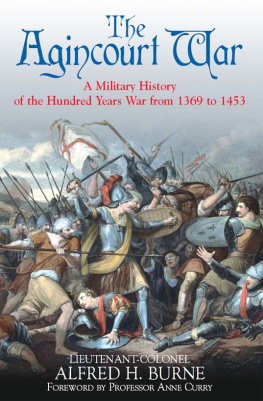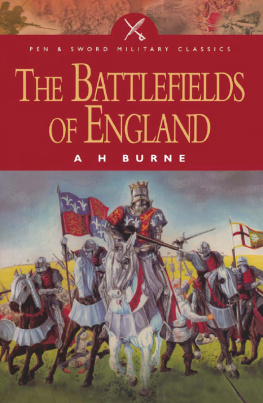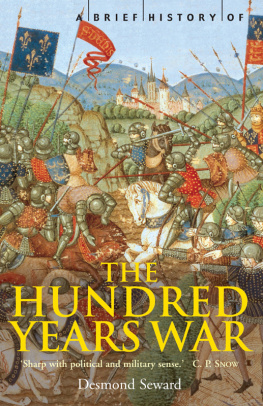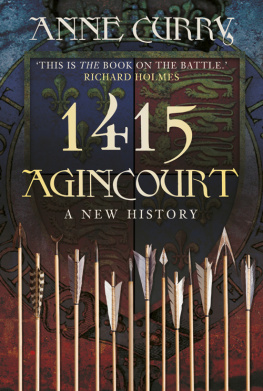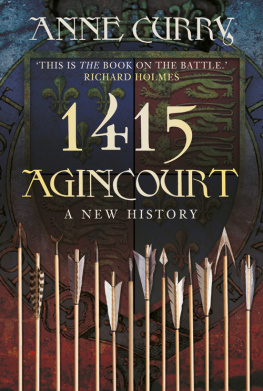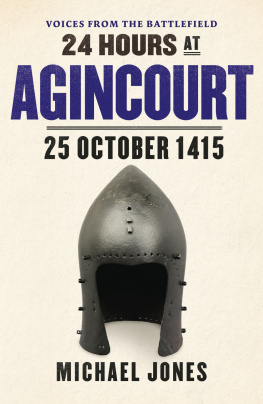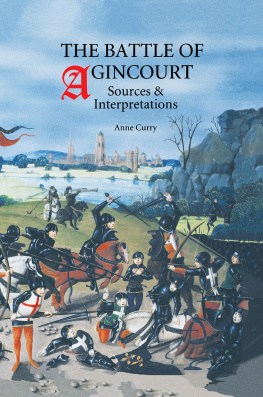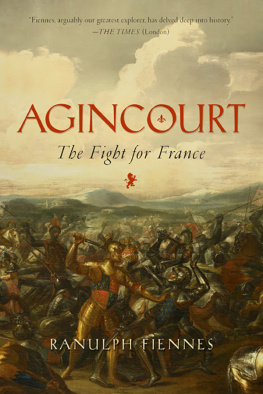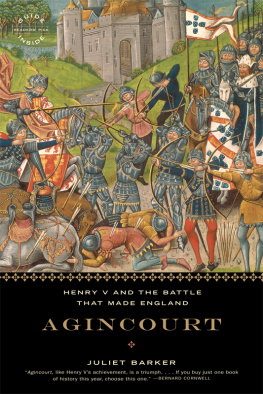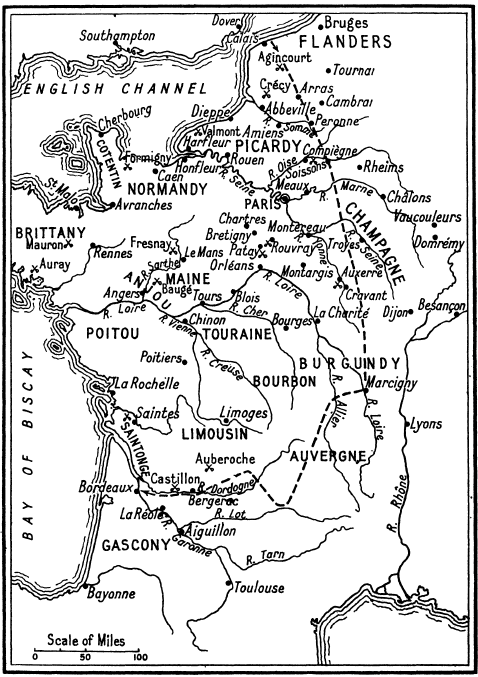The Agincourt War
The Agincourt War
A Military History of the Latter Part
of the Hundred Years War
from 1369 to 1453
Lieutenant-Colonel
Alfred H. Burne
D.S.O., F.R.Hist.S
The Agincourt War
A Greenhill Book
Published in Great Britain in 1991 by Greenhill Books, Lionel Leventhal Limited
www.greenhillbooks.com
This paperback edition published in 2014 by Frontline Books
an imprint of Pen & Sword Books Ltd,
47 Church Street, Barnsley S. Yorkshire, S70 2AS
www.frontline-books.com
Copyright Alfred H. Burne, 1956
Foreword Anne Curry 2014
The right of Alfred H. Burne to be identified as the author of this work has been
asserted by him in accordance with the Copyright, Designs and Patents Act 1988.
ISBN: 978-1-84832-765-8
Publishing History
First published in 1956 by Eyre & Spottiswoode, London.
All rights reserved. No part of this publication may be reproduced,
stored in or introduced into a retrieval system, or transmitted, in any form,
or by any means (electronic, mechanical, photocopying, recording or otherwise)
without the prior written permission of the publisher. Any person who does
any unauthorized act in relation to this publication may be liable
to criminal prosecution and civil claims for damages.
CIP data records for this title are available from the British Library
For more information on our books, please visit
www.frontline-books.com, email info@frontline-books.com
or write to us at the above address.
Printed and bound by CPI Group (UK) Ltd, Croydon, CRo 4YY
CONTENTS
FRANCE DURING THE HUNDRED YEARS WAR
John of Gaunts Grande Chevauche
W E are fast approaching the 600th anniversary of Agincourt on 25 October 2015. Henry Vs victory reversed the trend of the previous half century where the English had lost almost all the gains they had made under Edward III. French reluctance to face Henry in battle again enabled him to conquer the whole of Normandy between 1417 and 1419. The humiliation of Agincourt also served to exacerbate French political divisions. This culminated in the assassination of John the Fearless, duke of Burgundy on 10 September 1419 by the associates of the Dauphin, leader of the Armagnac faction. In a search for revenge, the Burgundians accepted Henry Vs terms: by the treaty of Troyes of 20 May 1420 he was recognised as heir to the throne of France by the French king, Charles VI. The Dauphin was disinherited. Henrys successes from Agincourt onwards placed the French at a disadvantage from which it took years to recover.
Alfred Burnes The Agincourt War was the first book to cover this exciting period in its entirety. Beginning with the low ebb of English fortunes in the 1370s Burne tells of the triumphs of 141520 but also of the eventual failure of English ambitions in France. By 1453 all was lost save for Calais. The Dauphin had been restored thanks to the inspiration of Joan of Arc.
The Agincourt War is itself almost sixty years old yet it remains a stimulating read. So too does its companion The Crcy War (1955) which covers the wars of Edward III. Yet history does not stand still. There has been a considerable amount of academic research on the Hundred Years War. We now have a much clearer idea of the international politics which sustained it, the armies which fought it and the civilians who suffered as a result of it. Historians have exploited the many unpublished records which Burne did not use, as well as providing a fuller and more nuanced interpretation
Nonetheless, Burnes book will retain a distinctive place because of the inspiration he took from his own experiences. Alfred Burne (18861959) served as an officer in the Royal Artillery as well as writing a number of books and articles on military history. He was aware that the reconstruction of history is largely conjectural, and this applies more to military than to any other branch of history.
His solution the concept of Inherent Military Probability has been criticised for imposing on the middle ages the mind of a twentieth-century soldier. Matthew Bennett remarked that Burne the Gunner sees English archery as a sort of battlefield artillery. But it is fascinating that a soldier of the First World War, a conflict now also being commemorated, felt such a strong affinity with his medieval counterparts that he was moved to explore and explain their actions.
Professor Anne Curry, 2014
For example, A. Ayton and P. Preston, The Battle of Crcy (2005), A. Curry, The Battle of Agincourt: Sources and Interpretations (2000) and A. Curry, Agincourt: A New History (2005).
J. Barker, Conquest: The English Conquest of France 14171450 (London, 2009); J. Sumption, The The Hundred Years War: Trial by Battle (1990), Trial by Fire (1999), Divided Houses (2009). Together these cover the period to 1399, with volumes on the fifteenth-century phase planned.
Below, p. 12.
M. Bennett, The Development of Battle Tactics in the Hundred Years War, in A. Curry and M. Hughes (ed.), Arms, Armies and Fortifications in the Hundred Years War (1994), p. 3.
M Y previous book on the Hundred Years War, The Crcy War, carried the story from its outbreak in 1337 to the Treaty of Bretigny in 1360. The war broke out again in 1369 and lasted, with some intervening truces, till 1453. It is this second war, or portion of the war, which, for want of a better title, I call The Agincourt War, that is described in the following pages. For all practical purposes it was two, if not three wars, for there was a truce from 1396 to 1415, while by the treaty of Troyes in 1422 the war changed its complexion, the governmental forces of both England and France combining to fight the forces of the Dauphin the King of Bourges.
Nevertheless, a central theme runs through the whole 116 years covered by the Hundred Years War the struggle to maintain an English dominion within the borders of what is now metropolitan France.
The military power and reputation of England was at its height in 1369. We shall see it wane, wax, and wane again. Though the art and conditions of war changed slightly during the course of this war, we shall see, at its beginning, knights in mail armour, and artillery in its infancy, at its end, knights in full plate armour, cap--pie, and artillery so powerful that it decided the issue in the last battle of the war.
Much of the campaign was spent in desultory siege operations, lacking in interest; by describing these operations briefly it has been possible to treat the battles in considerable detail.
Agincourt was the dominant battle of the wars, but there were several other battles so little less significant from a military aspect, that I have tried to rescue them from ever-increasing oblivion. In the same way, Henry V was the dominating personality on the stage, but while I have tried to do justice to his prowess and exploits I have tried to penetrate the blinding dazzle that surrounds him and which obscures the abilities and achievements of his chief lieutenants. These men are unknown even by name to most educated persons except where Shakespeare comes to their help

